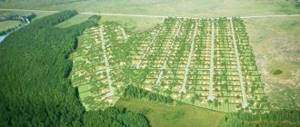geodetic works geodetic surveys geological basis land plot diagram engineering geodesy
Geodetic survey is a mandatory stage of land surveying. The data obtained during this stage is processed, and on its basis a topographic image of the area is created.
During the geodetic survey, not only the actual area of the territory and the coordinates of the boundaries are established, but also:
- characteristics of buildings, parameters of buildings erected on the site, taking into account the distances between them and the boundaries of the plot;
- terrain;
- information about communications available on the territory;
- information about access roads, and other information important for topography.
Geodetic survey of a land plot is necessary in order to obtain permission and begin the construction of a building on the site, or to lay utility networks. Also, information about the presence of minerals in the soil is revealed. In addition, geodetic surveys are necessary in the design and construction of commercial, private and industrial real estate, navigation for air and water transport, and in the process of assessing the condition of buildings erected on the site.
Calculation of the cost of services (price and duration)
What do you need to know about the land boundary plan?
A boundary plan of a land plot is a document that displays data about the plot and new information transmitted to regulatory authorities.
We are talking, for example, about information on dividing a plot, as well as changing boundaries and clarifying them. The boundary plan contains information about:
- Cadastral plan;
- Results of completed geodetic work;
- Information from land management documentation;
- Land ownership rights;
- Land belonging to municipal or state property;
- Formation of new plots by allocating shares in common property;
- Areas for which cadastral information is being updated.
When developing a boundary plan for a land plot, certain engineering and geodetic work is carried out. This is important for determining the real location of the land, calculating its area and securing boundaries. The finished document is certified by an official.
What does a topographic plan look like?
A graphic diagram of a land plot on a given scale with relief breaks, elevation marks of elevation changes, vegetation is also applied to the diagram, which can include trees, shrubs, alleys, and all underground and surface utilities are displayed. The topoplan displays roads, sidewalks and other transport infrastructure items.
Who needs a land boundary plan?
Land surveying and development of a plan may be required in a number of cases. This applies to the redistribution of the original plots and the formation of new ones, as well as the division of the plot. It is possible that a cadastral error was previously made in relation to this or that land, and then a boundary plan for the land plot will also be required.
Land surveying and drawing up a plan for the boundaries of a land plot are allowed to be carried out exclusively by cadastral engineers. Our company employs just such experienced specialists, helping numerous clients draw up documents in accordance with legal regulations. All of them are certified by government agencies.
What is included in a land plot plan?
The land plot plan includes two parts: text and graphic. They are formed from mandatory sections, as well as sections corresponding to specific types of cadastral work.
The elements of the text part are always the title page and contents. This part also includes:
- Background information;
- Data on measurements and calculations;
- Information about changed or newly formed areas, as well as their parts;
- Data on the procedure for access to sites;
- Data on the specified areas or their formed parts;
- Conclusion drawn up by a cadastral engineer;
- The act of agreeing on the location of borders.
The graphic part of the land plot plan presents diagrams of geodetic constructions, land locations, data on key points of boundaries and drawings of the plots themselves and their parts.
Document design principles
The conclusion of the cadastral engineer is included in the boundary plan of the boundaries of the land plot if, during the period of work, a discrepancy between the cadastral data on the boundaries of adjacent plots, settlements or municipalities is discovered with the real situation. In such cases, errors prevent the land from being registered in the cadastral register. The person performing the relevant work may insist on additional justification for the results. This section is presented in the form of coherent text material.
The land plot plan is carried out in electronic format or on paper. The cadastral engineer can certify it with an electronic signature, then there is no need for a paper version.
If the plan is drawn up on paper, one copy is sent to the cadastral registration authorities, the rest are transferred to the customer. Such a document is stitched, it is sealed with the signature of the cadastral engineer and his seal. The seal must also appear in the act confirming the approval of boundaries.
Differences between boundary plan, cadastral plan and boundary plan
A land plot plan is often confused with a boundary plan, although these are completely different concepts. The second document outlines the current boundaries of the land, their parameters, total length, as well as landscape features within the boundaries of the site. The boundary plan includes information about the newly formed areas. The process is marked here using arrows, dotted lines and other symbols. The only thing that unites the two types of plans is the accuracy of the image.
A land plot plan can be not only a boundary plan, but also a cadastral plan. There are also differences here. In essence, a cadastral plan is a map of a given area, on which information from the State Land Cadastre is displayed using graphics and text. The boundary plan can be considered a continuation of the cadastral plan and its addition. It was compiled taking into account the transformations that occurred after the registration of the cadastral plan. These changes are indicated by unifying or dividing lines.
Topographical plan of the area: general information about the drawing
Drawing up a topographic plan of an area is the most common task for surveyors. The document is created on the basis of the obtained plan elevations. We carry out work using an electronic total station, which allows us to perform measurements with high accuracy.
People contact us for topographic drawings for:
- creating landscape design;
- obtaining documentation of the construction site, buildings to be reconstructed, or the laying of new linear communications;
- carrying out new communications at the site;
- navigation map updates;
- creating tree documentation (drawings showing plantings).
A topographical plan of the area is a unique drawing. Our topographic documentation contains information about:
- boundaries of populated areas;
- roads;
- terrain features;
- water bodies: rivers, lakes;
- buildings and structures.
In geodesy, a topographical plan of an area displays all objects relative to their location to each other. On the drawings we indicate the coordinate system in which the survey was carried out. If necessary, from the drawing you can easily determine the coordinates and elevation of any object.
We carry out measurements only with accurate and verified instruments. All our instruments are certified.
The procedure for obtaining a boundary plan of a land plot
If you have a need for a land survey plan, you need to contact an organization that specializes in surveying and land management work. The activities of a cadastral engineer are divided into several stages:
- Collecting data about the site and studying it;
- Notifications of organizations and citizens whose rights are affected during land surveying
- Agreeing with them on all issues, including the boundaries of the site;
- Geodetic survey;
- Processing the results;
- Preparation of a land plot plan with subsequent registration;
- Transfer of documentation to cadastral registration authorities;
- Obtaining a cadastral passport, as well as an extract with the coordinates of the site.
If, at the stages of surveying or agreeing on the location of boundaries, disputes arise that cannot be resolved, the landowner will have to resolve them in court. True, this can only be done after the cadastral engineer has drawn up a document such as an approval act.
Topographic survey of a land plot
Topographic survey of a land plot is an indispensable tool in drawing up a package of project documentation
Topographic survey is a set of works aimed at creating topographic maps and plans of the area using measurements of geodetic points of the land plot on which the object is located. Geoworks are carried out to compile and update plans and maps, as well as to design and construct engineering structures of various kinds (civil and industrial buildings, roads, bridges, power lines, gas pipelines, etc.).
Using ground surveys or obtaining images of the earth's surface from aircraft, design organizations are able to obtain information on the location of objects and utilities for constructing topoplans. Aerial phototopography has gained particular popularity. It allows you to cover large areas for surveying from aircraft, including spacecraft.
Topographic survey of a site is a complex technological process. Many specialists take part in it using modern certified equipment and the latest software. This allows you to efficiently and accurately process the readings of topographic work, the result of which is a technical report.
Topographic plan
A topoplan is a large-scale drawing that depicts a small plot of land on a plane (scale 1:10,000 or more), built without taking into account curvature and maintaining a constant scale at any point and direction. There are plans that describe the exact terrain, objects and all ground communications in the form of points. Solid points are objects with clear boundaries - concrete, brick or other corners of permanent buildings, and non-solid points are contours without boundaries (edges of forests, meadows, etc.).
Why do you need a topographic survey of a site?
- To obtain permission to construct a building or any structure;
- To obtain permission to redevelop the communication network;
- To design a redevelopment project;
- To create a section project;
- To prepare documentation for establishing boundaries and determining the area.
Depending on the technical plan, topographic survey can be of several types:
- General and special purpose;
- Poderevnaya (with display of trees and dendroplane);
- Ground and underground engineering communications;
- Large scale;
- Control and executive;
- Landscape.
Large-scale topographic survey is the most in demand. It is produced in the following cases:
- Research;
- Drawing up master plans for territories;
- Topographic map updates;
- Landscape design;
- Drawing up working drawings;
- Vertical design.
The basis of topographic survey is a drawing that carries information about the exact data of structures, buildings, relief and vegetation in a certain area. The package of documents includes a statement of approval of all communications signed by executive authorities. Geodetic work takes place in several stages. First comes the preparatory process, where a technical plan is developed and documents are prepared. During the field stage of work, a study and analysis of the territory is carried out. Technical documentation in finished form is presented to the customer at the final – desk stage.
Depending on the type of object, topographic survey work includes:
1. Geodetic work during the construction of structures, buildings and complexes:
- Linking to local coordinate and elevation systems;
- Creation of a geodetic network at the construction site (reference plan-height);
- Layout of the construction site (horizontal and vertical);
- Calculation of the volume of earthworks;
- Carrying out the main structural elements, parts and axes of buildings up to 100 m in nature (including design axes inside the building in a single coordinate system);
- Accurate calculation of the area of the construction site and its perimeter;
- Vertical layout;
- Installation of factory equipment.
2. Geodetic work on the design and construction of linear structures:
- Production of topographic base;
- Tracing (desk and field);
- Carrying out the design axes in situ.
3. Engineering and geodetic surveys:
- Drawing up graphic and electronic topographic plans (scale 1:200; 1-5000);
- Creation of large-scale plans for an underground communication network.
4. Executive geodetic survey of completed construction projects, structures, complexes and components:
- Shooting after the fact, indicating deviations from the project;
- Control of object geoparameters.
Geobase
Surveying topographic and geodetic work ends with the presentation of engineering and topographic plans and a technical report to the customer. The geological basis is the site plan and the basis for design documentation. It is made on a scale of 1:500, but at the request and requirement of the customer, and also, depending on the specifics of further work, can be made in a different format. The shelf life of the geo-base is 3 years due to the high pace of construction.
As practice shows, topographic survey of a land plot is indispensable in drawing up a package of project documentation. One of the important tasks before the construction of any structure is competent and accurate geodetic work, which will be the key to a brilliant construction master plan and will help to avoid big troubles after the start of construction work.







